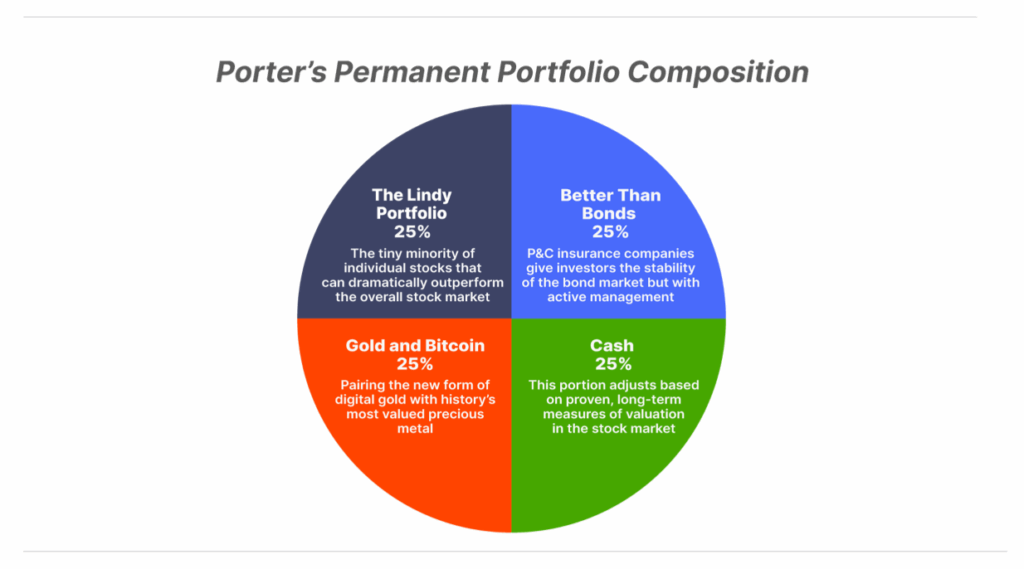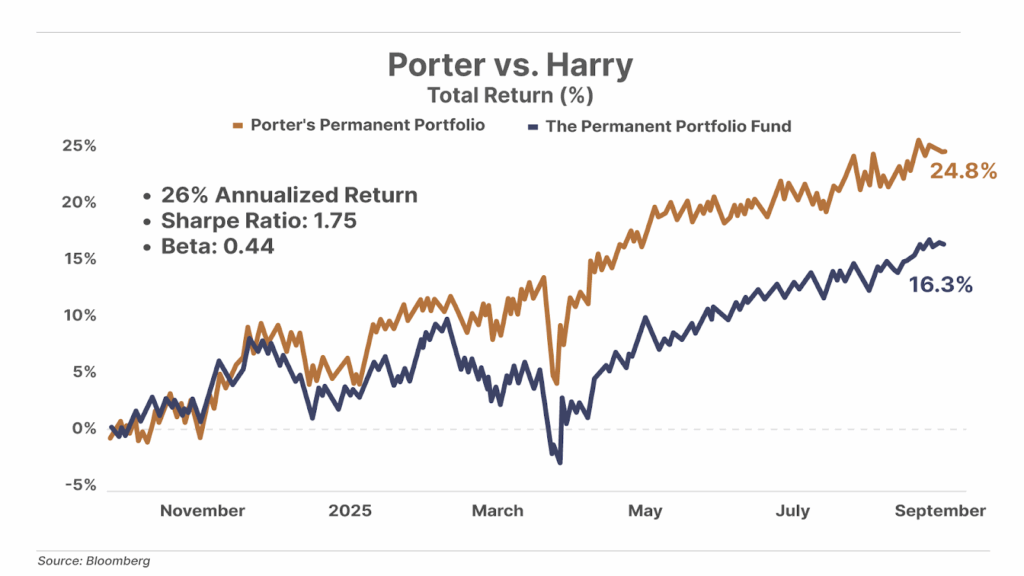
Our Revolutionary Strategy Has Dramatically Outperformed The Market
This Is Your Chance To Benefit
This is Porter & Co.’s The Big Secret On Wall Street, our flagship publication that we publish every Thursday at 4 pm ET. Once a month, we provide to our paid-up subscribers a full report on a stock recommendation, and also a monthly extensive review of the current portfolio, like we share below… You can go here to see the full portfolio of The Big Secret. Every week in The Big Secret, we provide analysis for non-paid subscribers. If you’re not yet a paid subscriber, to access the full paid issue, the portfolio, and all of our Big Secret insights and recommendations, please click here… At the end of this week’s issue, paid-up subscribers can find our Top 3 Best Buys, three current portfolio picks that are at an attractive buy price – get access to our top stocks. We explain how here… |
One year ago, Porter introduced a revolutionary idea to Porter & Co. readers.
It is an approach to investing where you don’t have to trade in and out of positions (in fact, it requires only a few adjustments, once a year)… where you don’t have to follow the news… where you don’t even have to worry about the future. It’s designed to protect and grow your money no matter what happens to the economy or the stock market.
Of course, we’re referring to Porter’s Permanent Portfolio.
This approach is based on the work of Porter’s friend and mentor – the brilliant author, philosopher, investor, two-time presidential candidate, and all-around wonderful human being, Harry Browne.
Harry’s idea was simple but brilliant. You see, he figured out that in a global economy dominated by paper money there would be a never-ending cycle of inflation, punctuated by short periods of deflationary recessions.
Therefore, Harry surmised that stocks would do well most of the time. But every now and then they’d crash, along with interest rates. And during those brief, deflationary periods, bonds would outperform.
Likewise, Harry understood that cash would smooth the volatility of both the stocks and the bonds in the portfolio – but that never-ending inflation would continuously erode the value of that cash. Therefore, holding gold would counter inflation and pay off over time.
So Harry suggested owning a portfolio allocated equally across each of those assets: 25% in stocks, 25% in bonds, 25% in gold, and 25% in cash, rebalanced annually.
In short, you own stocks. You hedge those stocks with bonds and cash. And then you hedge your bonds and cash with gold.
Harry Browne’s original Permanent Portfolio has largely performed as he expected since he created it in the 1980s. The Permanent Portfolio mutual fund (PRPFX), based on Browne’s concept, has compounded at around 7% a year since 1987, with extremely low volatility.
Its largest peak-to-trough decline was around 25% during the Great Financial Crisis. The long-term average return for the overall stock market is 8% a year, with a maximum drawdown of 50% during the financial crisis.
In other words, Browne’s portfolio has captured virtually all of the upside of the stock market, with roughly half the volatility… all while allowing investors to avoid frequent trading, ignore the news, and sleep soundly at night.
Most investors would be thrilled with those results. But Porter believed we could do even better – 2x better.
How Porter’s Permanent Portfolio Is Different (And Better)
Porter’s goal with Porter’s Permanent Portfolio was to improve Browne’s average returns without increasing the volatility of the portfolio – to create a superior Sharpe Ratio, which measures how much return is achieved per unit of risk. And he set out to achieve this through four important changes.
First, rather than simply owning a broad market index for our 25% equity allocation as Browne suggested, Porter recommended holding a small basket of individual stocks that can dramatically outperform the overall stock market. Specifically, he recommended holding what we here at Porter & Co. call ”Lindy” businesses – businesses with the relatively rare combination of excellent economics and long track records, of at least 40 years.
Relatively few companies in the world meet this lofty standard. But when we find one that does, it’s like discovering an untapped gold mine. Some well-known examples include Coca-Cola (KO), Johnson & Johnson (JNJ), and Philip Morris International (PM), which is why we have included these (along with others) in Porter’s Permanent Portfolio.
So while Porter matched Harry Browne’s 25% recommended equity allocation, he made a subtle, though significant, change to the strategy by only owning “Lindy” businesses in place of the entire market.
Second, rather than simply allocating 25% of the portfolio to long-term government bonds as Harry suggested, Porter recommended that investors own high-quality property and casualty (P&C) insurance companies instead.
This is an area of the markets that Harry Browne didn’t understand well. However, just as Browne’s portfolio strategy was based on mitigating risks, these businesses are directly involved in pricing and mitigating risk.
The best P&C firms, which have a proven track record of underwriting risk successfully, are, more or less, a gigantic pile of bonds with an underwriting unit on top. They own and actively manage huge portfolios of bonds. Owning these companies gives investors the stability of the bond market, but with active management (to help avoid losses due to inflation) and the additional underwriting profits that may accrue.
In other words, Porter’s Permanent Portfolio still owns a huge amount of bonds – but indirectly, through the “wrapper” of an insurance company.
Porter’s third change was to the gold allocation. Today, there’s a new form of gold on the world’s markets – Bitcoin – that simply didn’t exist during Harry’s time.
While Bitcoin is unlikely to ever replace gold, it does have many advantages over gold that are likely to continue to drive greater adoption as a percentage of global assets. So Porter recommended allocating 25% to a combination of both gold and Bitcoin-related assets rather than gold alone.
Finally, while Harry Browne recommended rebalancing all four portions of the portfolio to 25% annually, Porter made an exception for cash. Rather than simply rebalancing cash back to 25% of the portfolio each year, he recommended adjusting the cash portion on the basis of well-proven, long-term measures of valuation in the stock market.
In short, when the market is deeply undervalued, he recommended holding virtually no cash. But when the market is extremely overvalued – as we judge it is today – he recommended holding the full 25% allocation to “cash” through a select handful of safe, cash-like funds that pay a solid yield. Porter believed this willingness to modulate the amount of cash in the portfolio would further boost its long-term results.

Together, Porter promised these modifications would allow Porter’s Permanent Portfolio to produce even stronger absolute returns – up to double the long-term performance of Harry Browne’s original portfolio – with significantly less volatility than the major equity indexes, no matter what happens in the economy or the markets along the way.
That was a bold claim. And we suspect many readers were skeptical when he introduced the portfolio last fall. But anyone who has followed this approach over the past year has likely become a believer.
Since October, Porter’s Permanent Portfolio has returned 24.8% versus a return of 16.3% for Harry’s original Permanent Portfolio. (And though it’s not our goal, it also trounced the S&P 500’s 17% return over this period).
Yet despite tariff turmoil and other market shocks, it has done so with less than half the volatility (0.44 beta) of the S&P 500, producing an incredible Sharpe Ratio of 1.75.

If you know of a “set it and forget it” investment approach that outperformed Porter’s Permanent Portfolio over the past year, please let us know… because we haven’t found one yet.
If You Missed Out On These Extraordinary Gains, This Is Your Second Chance
The feedback we’ve received from subscribers on Porter’s Permanent Portfolio has been overwhelmingly positive. In fact, the only major complaint we’ve heard is from readers who missed our announcement last fall and weren’t able to benefit from this tremendous performance.
If you’re among them, we have some good news… This week, at our third-annual Porter & Co. Conference – live from his Maryland farm – Porter unveiled his latest version of Porter’s Permanent Portfolio.
As expected, this version includes an annual rebalancing of all four portions of the portfolio back to 25%, allowing new investors an ideal entry point. However, it also includes two additional subtle, yet significant, changes to the allocations.
First, he expanded the number of positions in The Lindy Portfolio from 11 to 20 individual companies, selected from across global equity markets. This change has two potential benefits for investors.
It allows those who prefer a more hands-off approach to diversify across a greater number of positions, further reducing single-stock risk (which is already quite low in Lindy equities).
However, it also presents the opportunity for those who prefer more concentrated portfolios to pick and choose to create their own portfolio of 11 to 12 favorites.
The second change Porter made was to the “Better Than Bonds” portion of the portfolio. While this portion is still allocated across six individual P&C companies, Porter changed the mix and allocation – including replacing two of the six companies – based on his latest analysis of the P&C industry.
Our backtesting suggests these changes should improve the expected returns of Porter’s Permanent Portfolio even further, with little to no change in volatility. In other words, if you’re not yet benefiting from this approach, there’s never been a better time to give it a try.
As we mentioned before, Porter unveiled these changes to Porter & Co. Partners at our conference yesterday, September 24. But if you weren’t able to join us, don’t worry…
We’ll be emailing the full, updated strategy – including everything an investor needs to know to get started – to all Partners and paid-up Big Secret On Wall Street subscribers tomorrow afternoon.
If you are not a paid-up subscriber, and you’d like to be among the first to receive it, click here to become a Big Secret subscriber now.
Porter & Co.
Stevenson, Maryland
New to The Big Secret Portfolio? Start With Our Top 3 Best Buys Today
Our goal at Porter & Co. is to bring you world-class investment research, focused on “inevitable” businesses that you can buy and hold forever. This is the surest and safest path to building permanent wealth.
While we don’t believe in timing the market, we do keep a constant eye out for bargains. In each edition of The Big Secret, we highlight three current portfolio picks that are at an attractive buy point. We suggest you focus on these.
Since we began compiling and tracking the performance of the Best Buys in February 2023, the companies on the list have generated a 41.4% return, while the overall market, measured with the S&P 500, has produced a 33.1% return.
This content is only available for paid members.
If you are interested in joining Porter & Co. either click the button below now or call our Customer Care team at 888-610-8895.